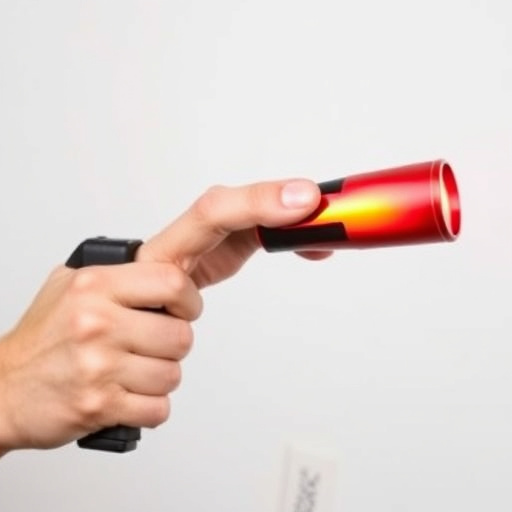Understanding and practicing the best bear spray application techniques (BSAT) is crucial for deterring and defending against aggressive bears. These include aiming directly at the bear's face and eyes from a safe 3-4 feet distance, using quick, short bursts, and choosing high-quality bear spray with optimal range and duration. Regular training, including simulated scenarios, builds muscle memory for swift responses. Proper post-exposure care and maintenance ensure the spray's effectiveness and longevity. Following these BSAT enhances safety during potential bear encounters in diverse landscapes.
In areas where wildlife encounters are common, personal protection against inflammatory agents like bear spray is crucial. This comprehensive guide delves into the world of bear spray, covering its composition and role in safety. We explore how to choose the best bear spray tailored to your needs, along with expert tips on effective application techniques for optimal protection. Additionally, we provide post-exposure care instructions to ensure your device remains reliable.
- Understanding Bear Spray: Composition and Its Role in Protection
- Choosing the Right Bear Spray for Your Needs
- Effective Application Techniques for Optimal Protection
- Post-Exposure Care and Maintenance of Your Bear Spray Device
Understanding Bear Spray: Composition and Its Role in Protection
Bear spray, also known as personal protection spray, is a powerful tool designed to deter and defend against aggressive bears. Its composition typically includes capsaicin, the active ingredient found in chili peppers, along with other chemical agents. This potent mix creates a noxious mist that irritates a bear’s eyes, nose, and respiratory system, temporarily disabling it and allowing for an escape or a chance to seek safety.
Mastering the best bear spray application techniques is crucial for its effectiveness. Aiming directly at the bear’s face and eyes from a safe distance ensures maximum impact. It’s recommended to use quick, short bursts rather than a prolonged stream, as this can blow the spray back towards the user. Understanding how to deploy bear spray in an emergency situation can make all the difference in bearing (no pun intended) the potential consequences of a bear encounter.
Choosing the Right Bear Spray for Your Needs
When selecting a bear spray, consider your specific needs and environment. Different sprays have varying concentrations of capsaicin, the active ingredient, ranging from 1% to 30%. Higher concentrations offer better protection against larger bears but may not be necessary for casual hikers or campers. Factors like can size, spray pattern, and range also differ; compact cans with wider spray patterns are ideal for close encounters, while longer-range options are better suited for open terrain.
Mastering the best bear spray application techniques is crucial. Practice targeting the bear’s face and eyes from a safe distance. Aim high, as bears have excellent sense of smell but limited upward vision. Ensure you follow manufacturer instructions regarding distance and duration of spraying. Regular training will improve your accuracy and response time during an actual encounter, making it a valuable skill for outdoor enthusiasts venturing into bear country.
Effective Application Techniques for Optimal Protection
When it comes to effective inflammatory agent personal protection spray, or best bear spray application techniques, understanding how and when to use it is crucial. The optimal method involves aiming for the face and eyes, as these are sensitive areas that can be quickly targeted. A short burst at close range (around 3-4 feet) is generally recommended, as it ensures maximum coverage without wasting valuable product. This precise application technique allows for swift de-escalation during encounters with potential threats.
Additionally, regular training and practice are essential to perfect these skills. Rehearsing the application process in simulated scenarios helps users develop muscle memory, ensuring they can respond quickly and accurately under pressure. It’s also vital to choose a high-quality spray designed for optimal range and duration, as this directly impacts protection levels. With proper training and the best bear spray application techniques, individuals can enhance their safety when facing potentially dangerous situations in outdoor environments.
Post-Exposure Care and Maintenance of Your Bear Spray Device
After using your inflammatory agent personal protection spray, proper post-exposure care is essential to maintain its effectiveness and ensure longevity. Start by thoroughly cleaning the device according to the manufacturer’s instructions. This involves removing any residual buildup or contaminants from the nozzle and internal components. Use a mild detergent and warm water solution, gently scrubbing the exterior and ensuring no residue remains.
Regular maintenance is key to optimal performance. Check the spray can for any signs of damage, corrosion, or leaks. Keep the device charged or stored with a full canister, as recommended by the manufacturer. Periodically test the spray mechanism to ensure it releases the correct amount of agent under pressure. Proper care and adherence to the best bear spray application techniques will help keep you safe and prepared for future encounters.
When it comes to protecting yourself in bear country, understanding and mastering the best bear spray application techniques is key. By choosing the right spray for your specific needs and learning effective application methods, you can significantly increase your safety during outdoor adventures. Remember, proper usage goes beyond just spraying; it involves understanding composition, distance, and follow-up actions. With the right knowledge and practice, you’ll be well-equipped to navigate encounters with these powerful animals. Always remember that prevention is key, but being prepared for an encounter makes all the difference in ensuring a safe outdoor experience.
